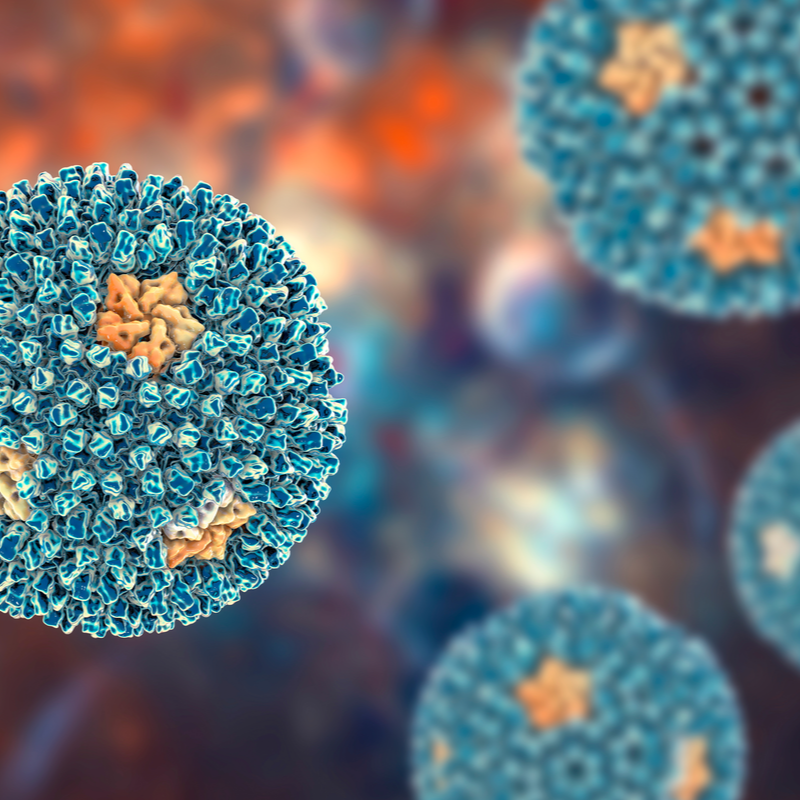
What is the reovirus?
The reovirus belongs to the Reoviridae and is an RNA virus. The name reovirus is the abbreviation of "respiratory enteric orphan", which already indicates that the virus makes itself felt through diseases of the gastrointestinal tract and the respiratory tract. However, the reovirus can also lead to asymptomatic infections
Where does the reovirus occur?
The reovirus is found all over the world. It is transmitted via the faecal-oral and aerogenic routes. Compared to many other viral infections, reoviruses do not have a seasonal cluster.
How does an infection with the reovirus develop?
It has not yet been conclusively clarified how the pathogenesis takes place. However, it can be assumed that the viruses use the M-cells of the lungs to gain access to the organism. It is also assumed that the viruses use the M-cells of the lungs to gain access to the organism. It is also assumed that the viruses enter the ileum epithelium via M cells of the Peyer's plaques after oral ingestion. The nerves located near the Peyer plaques can be used to infect the brainstem . Via the mesenteric lymph nodes, the virus can spread to the spleen. Spread to all organs is possible, but in most cases the reovirus remains confined to the lungs or gastrointestinal tract.
What is the morphology of the reovirus?
The mature virions are about 60-80 nm in diameter and have a non-enveloped, icosahedral capsid. The typical feature of most viruses from the Reoviridae family is the structure of the virion. It consists of two interwoven and closely interacting capsids. The genome has a double-stranded RNA, which is divided into about 10 to 12 segments.
What are the symptoms of the reovirus?
After the incubation period of about three days, depending on the localisation of the infection, there is an illness of the gastrointestinal tract, complaints such as pain and diarrhoea. Or a disease of the upper respiratory tract develops, which can be accompanied by pharyngitis and rhinitis .
In studies conducted with volunteers , the test subjects were inoculated with reoviruses, thus succeeding in clarifying the potential of the virus. Eight out of nine test subjects excreted the virus in their stool. In the person who did not excrete the virus via the stool, reovirus antibodies could be detected in the blood. In six of the nine test persons, a strong increase in the antibody titre developed and three persons became ill, while the symptoms lasted for about 4-7 days. The most common symptoms in these were:
- Pharyngitis,
- Rhinitis,
- Headache,
- Gastroenteritis,
- Cough.
In
other similarly conducted studies, mild
or no symptoms at all occurred in the minority. However, the majority of infections remained
asymptomatic.
In rodents, a infection of the central nervous system was observed in many cases, which were triggered by the reovirus. However, there are also isolated cases in humans in which the reovirus has spread to the central nervous system .
How is the reovirus diagnosed?
In order to be able to detect a reovirus , diagnostics based on virus isolation is essential. In this process, body fluids or tissues are examined serologically for antigen detection. Suitable materials include stool, throat swabs, nasal lavage fluid, urine and cerebrospinal fluid.
What complications can arise in connection with the reovirus?
As a rule, an infection with the reovirus runs its course without symptoms or with only mild symptoms. However, severe courses of the disease have been observed, especially in children between 6 months and 2 years of age. If the infection with reoviruses is not detected or is detected too late, dehydration can occur due to long-lasting diarrhoea. Without adequate countermeasures, this inevitably leads to death within a few hours due to exsiccosis. Reoviruses are equally dangerous when they attack the central nervous system and lead to inflammation of the brain. Here, too, an untreated reovirus infection is inevitably associated with death.
How is reovirus treated?
Most infections with the reovirus proceed without being noticed or noticed. No specific clinical picture can be assigned to them and severe courses or even complications only occur in extremely rare cases. For these reasons, no attempt has yet been made, or more precisely, no need has yet been seen to develop a therapy against the reovirus. Investigations and also studies have shown that the available drug Ribavirin is very effective also in use against the reovirus. Ribivarin prevents the formation of single- or double-stranded RNA and inhibits the protein synthesis of the virus.
Which people are particularly at risk from reoviruses?
Even if an infection with the reovirus mostly runs without symptoms and complaints, there are certain people who are more at risk than others. Babies and small children between 6 months and 2 years of age are at particularly high risk of dying of dehydration due to the long-lasting diarrhoea . However, people who are older or suffer from immunosuppression are also considered a particularly vulnerable group. For young and vital people whose immune system functions well without restrictions, there is a low risk of developing possible complications from the reovirus.
Is there an obligation to report the reovirus?
According to the Infection Protection Act, reoviruses do not have to be reported at all.
How can the reovirus be prevented?
In contrast to many other pathogens of the Reoviridae family, no severe diseases are triggered by the reovirus and treatment is usually only symptomatic. For this reason, no research or work is currently being done on a vaccination against the reovirus. At the present time, the development of vaccines against this virus is still not even being considered.
